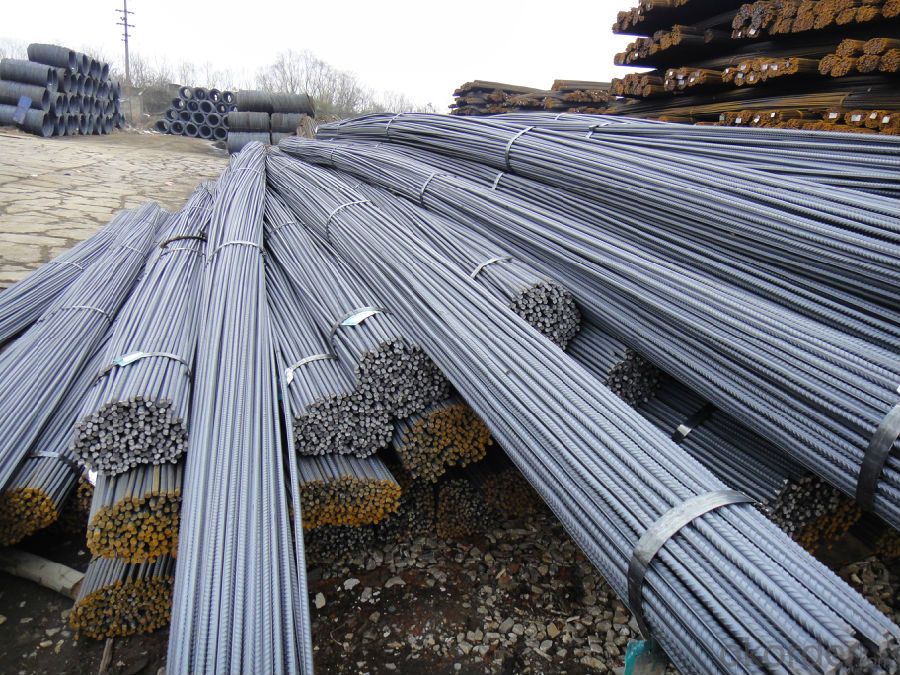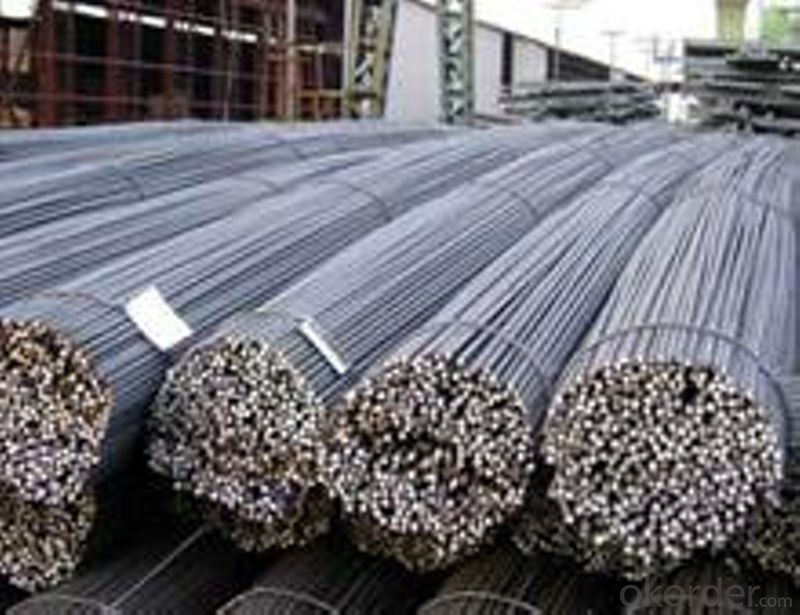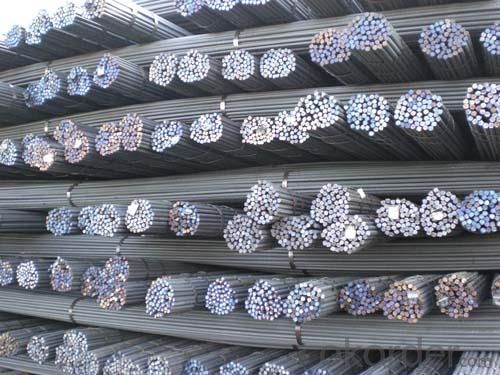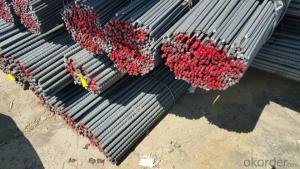HRB400 Deformed Steel Bar,Reinforced Deformed Steel Bar
- Loading Port:
- Tianjin
- Payment Terms:
- TT OR LC
- Min Order Qty:
- 30 m.t.
- Supply Capability:
- 100000 m.t./month
OKorder Service Pledge
OKorder Financial Service
You Might Also Like
Item specifice
Product Description:
Specifications of HRB400 Deformed Steel Bar,Reinforced Deformed Steel Bar
Standard | GB | HRB400 | |
Diameter | 6mm,8mm,10mm,12mm,14mm,16mm,18mm,20mm, 22mm,25mm,28mm,32mm,36mm,40mm,50mm | ||
Length | 6M, 9M,12M or as required | ||
Place of origin | Hebei, China mainland | ||
Advantages | exact size, regular package, chemical and mechanical properties are stable. | ||
Type | Hot rolled deformed steel bar | ||
Chemical Composition of HRB400 Deformed Steel Bar,Reinforced Deformed Steel Bar
Grade | Technical data of the original chemical composition (%) | ||||||
C | Mn | Si | S | P | V | ||
HRB400 | ≤0.25 | ≤1.60 | ≤0.80 | ≤0.045 | ≤0.045 | 0.04-0.12 | |
Physical capability | |||||||
Yield Strength (N/cm²) | Tensile Strength (N/cm²) | Elongation (%) | |||||
≥400 | ≥570 | ≥14 | |||||
Usage and Applications of HRB400 Deformed Steel Bar,Reinforced Deformed Steel Bar
Deformed bar is widely used in buildings, bridges, roads and other engineering construction. Big to highways, railways, bridges, culverts, tunnels, public facilities such as flood control, dam, small to housing construction, beam, column, wall and the foundation of the plate, deformed bar is an integral structure material. With the development of world economy and the vigorous development of infrastructure construction, real estate, the demand for deformed bar will be larger and larger..
Packaging & Delivery of HRB400 Deformed Steel Bar,Reinforced Deformed Steel Bar
Packaging Detail: products are packed in bundle and then shipped by container or bulk vessel, deformed bar is usually naked strapping delivery, when storing, please pay attention to moisture proof. The performance of rust will produce adverse effect.
Each bundle weight: 2-3MT, or as required
Payment term: TT or L/C
Delivery Detail: within 45 days after received advanced payment or LC.
Label: to be specified by customer, generally, each bundle has 1-2 labels
Trade terms: FOB, CFR, CIF
Images of HRB400 Deformed Steel Bar,Reinforced Deformed Steel Bar



- Q:What's the difference between rebar and thread steel?
- Different strength. The design strength of round steel (HPB235) is 210MPa; the strength of thread steel is higher than that of round bar; the design strength of HRB335 is 300MPa; the design strength of HRB400 is 360MPa.
- Q:What is the average weight of steel rebars per meter?
- The average weight of steel rebars per meter can vary depending on the specific size and type of rebar being used. However, as a general guideline, a common size of rebar such as a #4 (1/2 inch diameter) typically weighs around 0.668 kilograms per meter, while a #8 (1 inch diameter) can weigh approximately 2.67 kilograms per meter. It is important to consult the manufacturer or reference a reliable source to obtain the accurate weight of steel rebars per meter for a specific size and type.
- Q:How do steel rebars impact the overall aesthetics of concrete structures?
- The overall aesthetics of concrete structures are greatly influenced by steel rebars. Concrete is known for its strength and durability, but it lacks the ability to resist bending or stretching forces. This is where steel rebars come in. By reinforcing concrete with steel rebars, the structural integrity of the concrete is greatly improved. This allows engineers and architects to design more complex and ambitious structures, such as high-rise buildings, bridges, and stadiums. The use of steel rebars provides the necessary strength and flexibility to withstand heavy loads, seismic activity, and other environmental forces. However, the presence of steel rebars can impact the appearance of the concrete structure. In some cases, especially in exposed concrete finishes, the visibility of steel rebars can be seen as a visual distraction or an undesirable element. The exposed steel rebars may create a grid-like pattern or a rusty appearance, which can be perceived as unattractive or out of harmony with the surrounding environment. To address this aesthetic impact, various techniques are employed. One common approach is to use concrete coverings or coatings to hide the steel rebars and create a smooth and uniform surface. These coverings not only improve the appearance but also protect against corrosion and prolong the lifespan of the structure. Another method is to use decorative techniques like formwork or molds to create unique patterns or textures on the concrete surface. This way, the steel rebars are concealed within the design, enhancing the overall aesthetic appeal of the structure. By incorporating architectural features such as curves or geometric shapes, the presence of steel rebars can be turned into a visual asset instead of a hindrance. It is important to note that in certain architectural styles, like Brutalism, the raw and exposed nature of concrete structures, including the visibility of steel rebars, is celebrated as an artistic expression. In these cases, the industrial and utilitarian aesthetic is embraced, and the steel rebars become an integral part of the overall design concept. In conclusion, steel rebars have a significant impact on the aesthetics of concrete structures. While their presence can sometimes hinder achieving the desired visual outcome, various techniques and design approaches can be used to either conceal or incorporate steel rebars into the overall architectural design, resulting in visually pleasing and structurally sound concrete structures.
- Q:What is the process of reinforcing concrete columns with steel rebars?
- The process of reinforcing concrete columns with steel rebars involves several steps. First, the design and layout of the rebars are determined based on the structural requirements and load calculations. Then, the concrete formwork is constructed to shape the column. Next, the rebars, typically made of high-strength steel, are placed in the formwork according to the designed layout, ensuring proper spacing and alignment. The rebars are often tied together using wire or mechanical connectors to maintain their position during the concrete pouring. Once the rebars are securely in place, concrete is poured into the formwork, encasing the rebars and forming the column. The concrete is then left to cure and harden, creating a strong and durable composite structure of concrete and steel.
- Q:What is the process of connecting steel rebars to structural members?
- To establish a secure and dependable connection, several steps are involved in connecting steel rebars to structural members. To begin with, the structural member's design specifications necessitate the precise positioning of the long, ridged or deformed steel bars called rebars. This is typically accomplished by using spacers or chairs to maintain the appropriate spacing between the rebars and the surrounding formwork. Following that, the rebars are connected to the structural member through various means. A common method is lap splicing, where the rebars overlap for a designated distance and are then tied together using wire or mechanical connectors. The length of the overlap is determined by engineering calculations to ensure adequate strength and load transfer. Another approach involves the use of pre-fabricated mechanical couplers, which provide a dependable connection between the rebars. These couplers are designed to securely grip the rebars and effectively transfer the load. They offer advantages such as quicker installation, reduced labor costs, and enhanced structural integrity. In addition to splicing, the rebars may also need to be anchored or hooked into the structural member. Anchoring involves extending the rebar's length beyond the connection point and bending it back into the concrete to create a hook shape. This provides additional resistance against pull-out forces. Throughout the process, it is crucial to ensure that the rebars are clean, free from rust, and properly aligned. Any contaminants or misalignments can weaken the connection and compromise the structural integrity. Therefore, comprehensive inspection and quality control measures are essential to ensure a successful connection. Overall, the process of connecting steel rebars to structural members requires meticulous planning, precise positioning, proper splicing or coupling, and thorough inspection. By following these steps, a robust and long-lasting connection can be achieved, guaranteeing the safety and stability of the structure.
- Q:What is the recommended minimum cover for steel rebars in concrete?
- The recommended minimum cover for steel rebars in concrete is typically 1.5 inches for interior applications and 2 inches for exterior applications. However, it is important to consult the local building codes and engineering specifications for specific project requirements.
- Q:How do steel rebars improve the structural integrity of concrete?
- Steel rebars improve the structural integrity of concrete by providing reinforcement and added strength to the material. They are embedded within the concrete, acting as a framework that helps to distribute and carry loads more effectively, preventing cracks and enhancing the overall durability and stability of the structure.
- Q:What is the role of steel rebars in minimizing the risk of concrete spalling due to sulfate attack?
- Steel rebars play a crucial role in minimizing the risk of concrete spalling due to sulfate attack by providing reinforcement and increasing the overall strength of the concrete structure. When concrete is exposed to sulfate ions, it can undergo a chemical reaction that leads to expansion and cracking, resulting in spalling. However, steel rebars act as a reinforcement, helping to distribute the stress and load throughout the concrete, reducing the risk of cracking and spalling. Additionally, the presence of rebars helps to maintain the structural integrity of the concrete, preventing the ingress of sulfate ions and minimizing the potential for sulfate attack.
- Q:How are steel rebars tested for quality?
- Steel rebars are tested for quality through various methods such as visual inspection, dimensional checks, and destructive testing. Visual inspection involves examining the rebars for any surface defects or abnormalities. Dimensional checks ensure that the rebars meet the specified size, length, and weight requirements. Destructive testing involves subjecting the rebars to tension, compression, and bending forces to assess their strength, ductility, and overall performance. These tests help ensure that steel rebars meet the necessary quality standards for construction purposes.
- Q:What is the impact of steel rebars on the overall carbon footprint of a building?
- Steel rebars have a significant impact on the overall carbon footprint of a building. The production of steel involves high carbon emissions, contributing to greenhouse gas emissions and climate change. Additionally, the extraction of raw materials and the transportation of steel rebars further increase carbon emissions. However, steel rebars provide structural strength and durability, reducing the need for future repairs or replacements. Therefore, while the use of steel rebars does contribute to the carbon footprint, proper construction practices and efficient use of materials can help mitigate their environmental impact.
1. Manufacturer Overview |
|
|---|---|
| Location | |
| Year Established | |
| Annual Output Value | |
| Main Markets | |
| Company Certifications | |
2. Manufacturer Certificates |
|
|---|---|
| a) Certification Name | |
| Range | |
| Reference | |
| Validity Period | |
3. Manufacturer Capability |
|
|---|---|
| a)Trade Capacity | |
| Nearest Port | |
| Export Percentage | |
| No.of Employees in Trade Department | |
| Language Spoken: | |
| b)Factory Information | |
| Factory Size: | |
| No. of Production Lines | |
| Contract Manufacturing | |
| Product Price Range | |
Send your message to us
HRB400 Deformed Steel Bar,Reinforced Deformed Steel Bar
- Loading Port:
- Tianjin
- Payment Terms:
- TT OR LC
- Min Order Qty:
- 30 m.t.
- Supply Capability:
- 100000 m.t./month
OKorder Service Pledge
OKorder Financial Service
Similar products
New products
Hot products
Related keywords




























